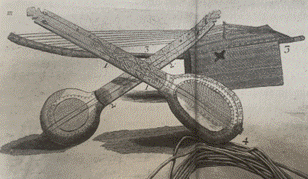By Madeline Ricks
Serving with Augusta Heritage Center
Madeline Ricks is an AmeriCorps member with AFNHA, serving as the Collections Preservation Coordinator for The Augusta Heritage Center in Elkins, WV. She has begun writing a new blog series for the Augusta website. Beginning with the African origins of the banjo, which is up now on the Augusta Heritage Center’s website under the blog section, Madeline will take readers on a journey through the histories and cultural impacts of the instruments played in West Virginia’s musical traditions. As the Augusta Heritage Center’s Preservation Coordinator, Madeline is responsible for digitizing, collecting, and organizing their vast archive, as well as writing blog posts on West Virginia history, happenings, and culture to increase engagement with the archive and the organization. The blog series will use academic research, recordings and photographs from the Augusta Archive, and other historical images. Madeline is a recent master’s graduate from the University of St Andrews in Scotland. This summer she researched West Virginia’s traditional music community, interviewing musicians and collecting life stories in order to analyze what it means to play traditional music in a contemporary, often festivalized setting. This research led her to love West Virginia’s music culture and inspired her to give back to the communities she studied through AFNHA’s AmeriCorps program. She hopes this blog series inspires others to look into their local histories and the music that surrounds them.
Here is a small sample of the blog post, and a hint at what’s to come:
The banjo as an instrument can be traced back to instruments brought or made by enslaved people from West Africa to colonies across the Americas. The instrument we think of today looked very different from the many stringed instruments that could have merged to form the modern banjo over centuries. Historian Kristina Gaddy writes in her book, Well of Souls, “Only three early gourd-bodied, African american-made banjos exist today...Known images of the banjo before 1820 number less than fifteen” (Gaddy 2022:xiv). The oldest surviving appearance of an instrument resembling the banjo was drawn by Sir Hans Sloane, a British naturalist and physician in Jamaica, who later went on to found the British Museum. Here he drew two stringed, gourd-bodied instruments, which he called “Strum Strumps” around 1687-1689 (Gaddy 2022: 15).
1707 engraving of Hans Sloane’s “Strum Strumps” (Gaddy 2022:15)
…
Writing about her experience as a white girl on a plantation in Mississippi, Susan Dabney Smedes remembered that when the enslaved people joined the Baptist Church, they stopped playing instruments. The ‘most music loving fellow’ told the preacher that he’d broken his fiddle and banjo and thrown them away” (Gaddy 2022: 214).This shows clearly that as late as the 19th century, banjos were considered valuable spiritual objects to black people across the Americas and in order to assimilate into another religion, the musical object must be rejected.
…
Gerry Milnes writes, in a 2017 article in Goldenseal magazine, “Early references in this country call the instrument a ‘banza’ or ‘banjil,’ which evolved into the colloquial ‘banjer,’ noted in the Maryland Gazette in 1754. In 1781, speaking about enslaved Africans African slaves, Thomas Jefferson said, ‘The instrument proper to them is the Banjar which they brought hither from Africa.’
Stay Tuned: Visit the Archive
A “peghead banjo created by black musician in Southern West Virginia, constructed from Carnation condensed milk cans glued to a wooden box” - Photographed by Gerry Milnes (Augusta Archive 1991, 2024)
The first installment in the West Virginia Instrument Anthology, The African Origins of the Banjo, is part one in the banjo’s history in the wider Americas and West Africa, at one point using an image of an African-American made banjo from the Augusta Archive. Part two ,which will be posted soon after, narrows into the banjo’s history in nineteenth century and into the modern day. It will attempt to answer historian Kristina Gaddy’s question: “Why was it that an instrument constantly described as ‘Black’ and ‘African’ came to be thought of as a white instrument?” (2022:177). The blog series is not just a pet project of Madeline’s, but a way to show how The Augusta Heritage Center’s open-access, digital archive can be used to aid research and learning about West Virginia culture and music history. Stay tuned for the next installation in the anthology and make sure to visit the digital archive for your own interests, research, and connection to local history!
Read the African Origins of the Banjo Blog: https://augustaartsandculture.org/african-origins-of-the-banjo-part-one-of-the-west-virginia-instrument-anthology/
Explore the Augusta Archive: https://augustaartsandculture.org/document-library/
Works Cited:
Augusta Archive 2024. Peghead banjo handcrafted by a Black musician from southern WV, Augusta Heritage Center, Photographed by Gerry Milnes Aug 1991, Available on-line (augustaartsandculture.org/document/peghead-banjo-handcrafted-by-a-black-musician-from-southern-wv-4/ and augustaartsandculture.org/document/peghead-banjo-handcrafted-by-a-black-musician-from-southern-wv/).
Gaddy, K. 2022. Images in Well of Souls: Uncovering the Banjo’s Hidden History, Kristina R. Gaddy, Available on-line, (kristinagaddy.com/blog/images-in-well-of-souls-uncovering-the-banjos-hidden-history).
Gaddy, K. 2022. Well of Souls: Uncovering the Banjo’s Hidden History, W.W. Norton & Company, Inc., New York, NY.
Mazow, L. 2005. Picturing the Banjo, The Pennsylvania State University Press, University Park, PA.
Milnes, G. 2017. ‘The Banjo in West Virginia’, Goldenseal Magazine, Spring 2017, pp. 40-47.




